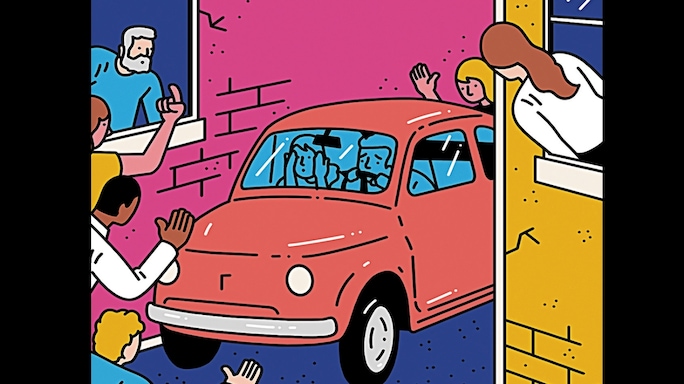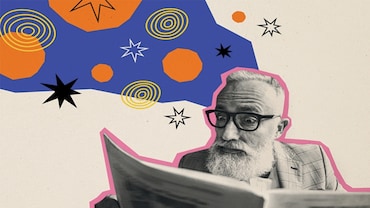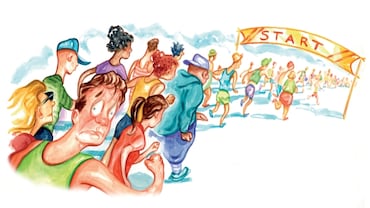I'm a Hero Behind the Wheel
All the trouble with driving
 ILLUSTRATION BY Sam Island
ILLUSTRATION BY Sam Island
The automobile industry is spending billions on self-driving cars, just so we can sit in the back seat being chauffeured around, like some high-powered corporate executive. But what if we quite like driving?
On holiday a few years ago, I spent hours being transported on trains, buses and planes. You sit there, bored and fidgeting. You read a novel for a while, then stare glumly out the window. You wonder if the bus driver or train driver or pilot could do with a little bit of assistance. You’ve been turned into cargo, being shifted from one location to another.Then, finally, comes the section of the holiday during which you hire a set of wheels. Oh boy. Suddenly, the cargo has been given agency. It’s even more fun if you are driving on the side of the road opposite to what you are used to.
After decades of marriage, it’s not often that you receive unalloyed praise from your partner, but on the highways of Crete compliments come with every successful manoeuvre.
“Oh, well done!” says Jocasta, her voice full of admiration, as I navigate a roundabout without killing us both.
“Just put me in the gutter,” she adds as we make a left turn, helping me to remember what side I should be driving on. It sounds like a scene from Fifty Shades of Grey, but is merely a reminder that the passenger should find themselves closest to the outer edge of the road.
Better still, the car has gears, as opposed to my automatic-transmission vehicle back home. Into the roundabout I go, shifting down as we enter, then back up to fourth gear as we return to the straight. Really, it’s like driving in a Formula One race.
We turn right, then right again, following the GPS navigation system, and find ourselves in a small Cretan town. I speak sternly to the GPS: “We don’t want to be here; we want the highway.
”It instructs me to turn right once more. With every turn, the street narrows. It’s like being in a magical shrinking room. We retract the side mirrors. We take another turn. The new road is even narrower, the walls so close you feel compelled to hold your breath.
Another car appears, coming towards us from the opposite direction. The driver gesticulates, telling me I’ll have to make way. But how? I don’t have the nerve to back up along the impossibly narrow road.Locals emerge. Soon there’s a whole group—friendly, helpful—using sign language to suggest a solution. There’s a narrow garage opening to one side, a minuscule side street to the other. If I can squeeze the car forward into the garage, I could then, through a series of microscopic adjustments, back into the side street, allowing the other car to pass.
More locals arrive, standing on various sides of the vehicle, helpfully indicating that I have a centimetre to spare here, a millimetre there, and, really, I could afford to swing in harder on the right rear.There are brick walls on all 17 sides of the car.There’s zero chance that I won’t damage the vehicle. This is significant since, a day earlier, at the Europcar counter, I had refused the additional insurance, despite Jocasta’s strenuous insistence that it was the sensible option.
I put it this way: “Everyone knows it’s a rip-off. Besides which, I don’t intend to crash the car.”
To which Jocasta responded: “That’s the most stupid thing you’ve ever said, and, Lord, there’s some competition.”
Back in the small town, more locals continue to arrive. Soon it will be the mayor and a brass band. One lady stands at the rear of the vehicle, waving me on. She’s making vigorous “this way, this way” movements with her arms, which, translated from the Greek, mean “Oh, get on with it. There are at least three centimetres between you and this wall. What’s so difficult?” In an act of blind trust, I follow her instructions, creeping backwards and forwards. Remarkably it works. I complete my 27-point turn into the side street, with no damage to the vehicle. The other car passes. The driver gives me a grateful wave. I follow her lead, down the narrow lane and—finally—back onto the highway.Free of the town, I pull over. It’s been some time since Jocasta’s last “well done.” My hands are trembling. I get out of the car, breathe in and out to steady my nerves, then reluctantly climb back behind the wheel.
Jocasta swivels towards me. “You’re my hero,” she says. I glance towards her, expecting the shadow of a teasing smile, but can find none. “You’re my hero,” she repeats. She squeezes my hand. We set off again. Before long, we head into another roundabout and emerge alive on the other side. “Well done,” says Jocasta.
I accelerate into the straight. Third gear, fourth—I may choose to go into fifth. Who would swap all this for a self-drive car?
This column was first published in the Sydney Morning Herald.






